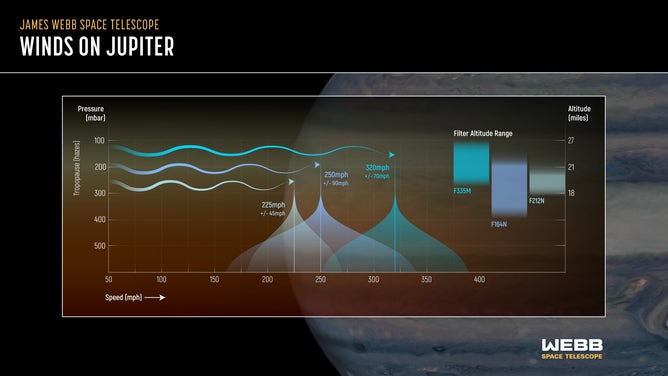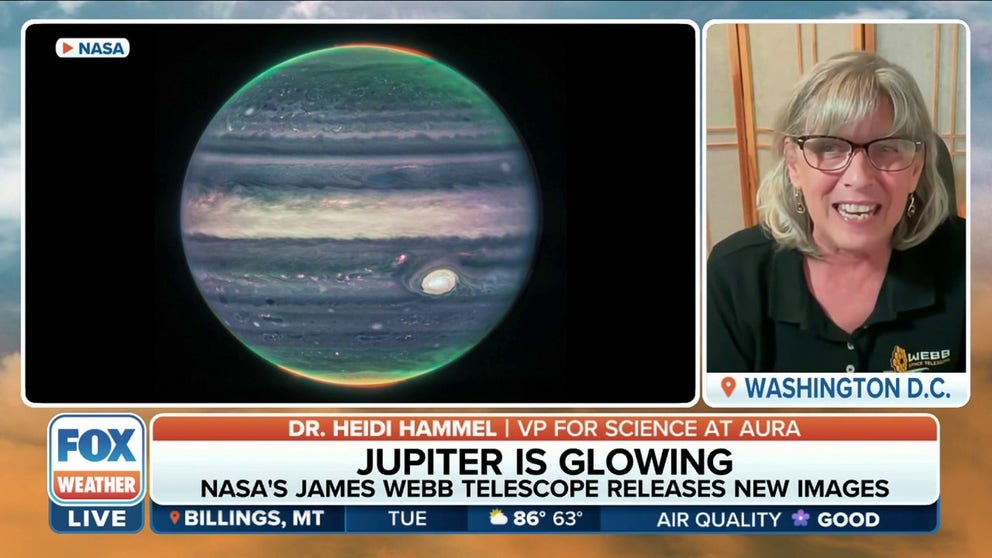Webb Telescope spots new weather feature on Jupiter moving twice as fast as Category 5 hurricane
The jet stream in Jupiter's lower stratosphere is moving at estimated speeds of about 320 mph, twice the sustained wind speeds of a major Category 5 hurricane on Earth. Images taken by James Webb Space Telescope continue to reveal new details about Jupiter's turbulent weather.
James Webb Telescope captures groundbreaking Jupiter haze layer, ring images
Vice President for Science at AURA and NASA Interdisciplinary Scientist for the James Webb Space Telescope Dr. Heidi Hammel says the telescope has the range to see a bright planet and rings next to it a million times fainter.
Images taken of Jupiter by NASA's James Webb Space Telescope show a roaring jet stream over the gas giant's equator that is moving at speeds twice as fast as the winds of a Category 5 hurricane, according to a new study.
Last year, soon after Webb began scientific observations, NASA, the European Space Agency and the Canadian Space Agency released images of Jupiter taken on July 27 using the telescope's Near-Infrared Camera (NIRCam) instrument.
In the image below, Jupiter's Great Red Spot and other swirling weather features can be seen in the high-resolution photos processed by citizen scientist Judy Schmidt. Since the images were taken, a group of international scientists, part of the Early Release Science program, have found surprisingly detailed features within Jupiter's turbulent atmosphere. Their findings were published Thursday in the journal Nature Astronomy.

Webb NIRCam composite image of Jupiter from three filters – F360M (red), F212N (yellow-green), and F150W2 (cyan) – and alignment due to the planet’s rotation. (Credit: NASA, ESA, CSA, Jupiter ERS Team; image processing by Judy Schmidt.)
According to the study, a newly discovered jet stream was found above Jupiter's cloud tops. This jet is moving at an estimated speed of about 320 mph, twice the sustained wind speeds of a major Category 5 hurricane on Earth.
"This is something that totally surprised us," said the paper's lead author Ricardo Hueso of the University of the Basque Country in Spain. "What we have always seen as blurred hazes in Jupiter’s atmosphere now appear as crisp features that we can track along with the planet’s fast rotation."
JUPITER'S FORECAST: SWIRLING STORMS AS BIG AS EARTH THAT LAST FOR YEARS
The science team compared JWST observations with deeper winds observed by the Hubble Space Telescope to determine how fast the winds change with altitude and generate wind shear.
The image below highlights some of the areas where wind shear is disturbing features around Jupiter's equator.

On the left, Jupiter as seen by JWST's NIRCam. On the right, a zoomed in view of Jupiter's equatorial jet stream highlighting several features disturbed by the motion of the jet stream. (Image: NASA, ESA, CSA, STScI, Ricardo Hueso (UPV), Imke de Pater (UC Berkeley), Thierry Fouchet (Observatory of Paris), Leigh Fletcher (University of Leicester), Michael H. Wong (UC Berkeley), Joseph DePasquale (STScI)
(NASA)
The jet stream moving at 320 mph is located about 25 miles in altitude in Jupiter's lower stratosphere.
The science team found the jet stream by isolating different wind speeds within different layers of Jupiter's atmosphere during the observations taken 10 hours apart, which equals one day on Jupiter.

A graph showing the pressure (mbar) and wind speed (mph) at different altitudes (miles) in Jupiter's atmosphere. (Image: NASA, ESA, CSA, STScI, Ricardo Hueso (UPV), Imke de Pater (UC Berkeley), Thierry Fouchet (Observatory of Paris), Leigh Fletcher (University of Leicester), Michael H. Wong (UC Berkeley))
(NASA)
As Webb takes more observations of Jupiter, the researchers hope to learn if the jet stream's speed and altitude change over time.
SEE THE ‘WHIRLWIND’ OF IMAGES TAKEN DURING JAMES WEBB SPACE TELESCOPE'S FIRST YEAR
"Jupiter has a complicated but repeatable pattern of winds and temperatures in its equatorial stratosphere, high above the winds in the clouds and hazes measured at these wavelengths," said study co-author Leigh Fletcher of the University of Leicester. "If the strength of this new jet is connected to this oscillating stratospheric pattern, we might expect the jet to vary considerably over the next 2 to 4 years – it’ll be really exciting to test this theory in the years to come."
After launching on Christmas morning in 2021, the powerful James Webb Space Telescope began science observations in July 2022, about 1 million miles from Earth. NASA estimates the telescope will operate for decades to come.
